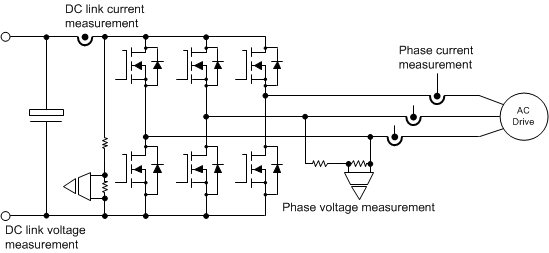SPRAD53 December 2022 F29H850TU , F29H859TU-Q1 , TMS320F280025C , TMS320F280039C , TMS320F280049C , TMS320F28379D , TMS320F28388D , TMS320F28P650DH , TMS320F28P650DK , TMS320F28P650SH , TMS320F28P650SK , TMS320F28P659DH-Q1 , TMS320F28P659DK-Q1 , TMS320F28P659SH-Q1
2 System-Level Application
Delta-sigma modulation is used to measure current and voltage levels in power systems such as the AC motor drive shown in Figure 2-1. Shunt-based isolated delta-sigma modulators are often used for current and voltage sensing in 3-phase inverters due to their high accuracy and high bandwidth, while offering lower system cost.
 Figure 2-1 Current and Voltage
Measurement in Three-Phase Inverters
Figure 2-1 Current and Voltage
Measurement in Three-Phase InvertersDelta-sigma modulators are ADCs that allow for continuous oversampling of analog inputs through a delta-sigma modulator and require a digital/decimation filter. The voltage drop across a shunt resistor can be measured by a delta-sigma modulator to enable current sensing. A delta-sigma modulator converts an analog input signal into a high-frequency stream of single bits with out-of-band noise. The advantages of moving the quantization noise to higher frequency bands include simple anti-aliasing filtering, low-cost solution by eliminating cost on drivers, and scalable performance. This leads to reduced overall system cost while providing high performance.
Figure 2-2 shows a block diagram showcasing shunt resistor and delta-sigma modulator for phase current measurement in a three-phase inverter design.
The AMC1306 device requires a low-side supply which can be supplied by the 3.3 V rail supplying the C2000 device. The AMC1306 also requires an isolated 3.3 V or 5 V high-side supply (AVDD) which is generated from the isolated high-side gate driver supply by an LDO. The AMC1306 takes as inputs the differential voltage across the shunt resistor on the high-side and the clock supplied by the C2000 device on the low-side. The output of the modulator can be fed into the SDFM peripheral of the C2000 device.
The AMC1306 device's fail-safe conditions, which are described in greater detail throughout this report, provide indication into potential system faults.
One of the fail-safe conditions occurs when the high-side power supplied into the AMC1306 device is not present. Presence of this fail-safe could indicate an issue with the high-side gate driver supplying AVDD. It could also indicate an issue with the LDO used to step-down the voltage into the device.
Another fail-safe condition, known as common mode overvoltage, can be used to indicate a missing or disconnected shunt resistor. If AINN or AINP is disconnected from the shunt resistor, the input bias current of the AMC1306 drives the disconnected terminal towards the positive supply rail, and the common-mode input voltage increases. A similar effect happens when there is no DC current path between AINN, AINP, and AGND. This fail-safe condition is useful to identify interconnect problems on the board.